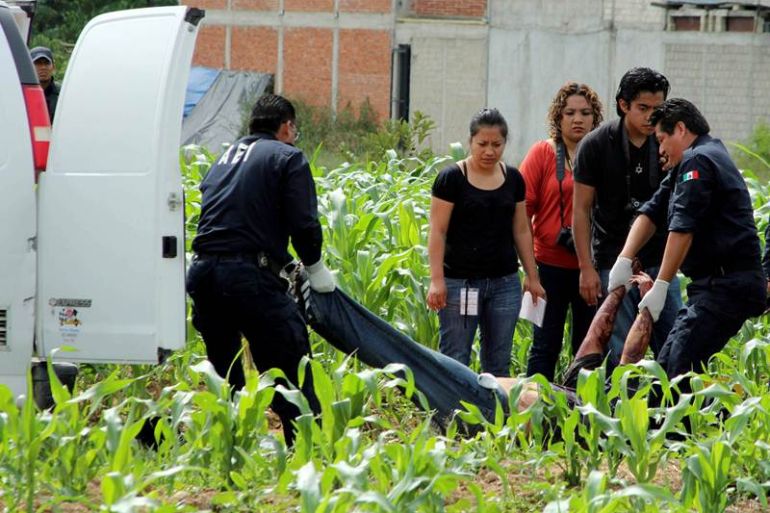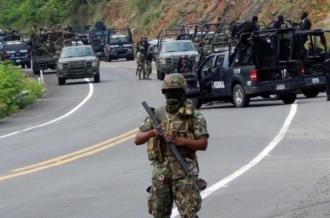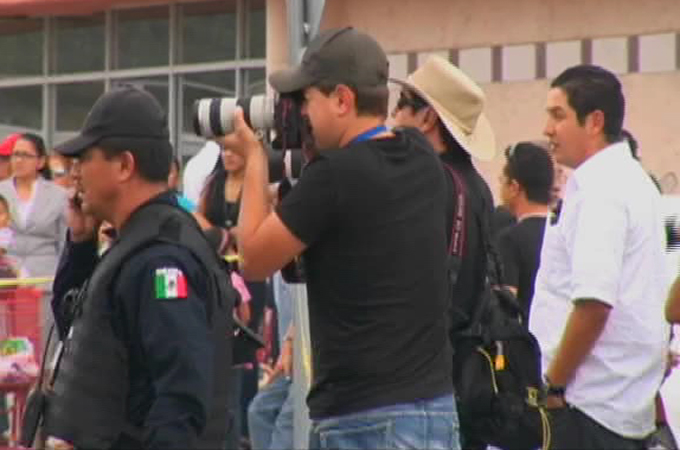Mexican journalists targeted
Journalists in Mexico continue to be killed and harassed even after institution of new protective laws.

Mexico City, Mexico – Amid the recent fanfare surrounding big arrests in Mexico’s drug war, those journalists still daring to shed light on the cartels and corrupt state officials keep on dying, and the killers, they just keep on getting away with it.
Alberto Lopez Bello was recently found shot dead in Trinidad de Viguera, a small town near the southern city of Oaxaca. The 28-year-old had worked the crime beat on the state-wide daily newspaper El Imparcial for the past six years. His beat up body was found alongside that of a young policeman, hours after the pair were seen drinking in a downtown bar. The killings took place as thousands of tourists descended on Oaxaca for the famed Guelaguetza cultural festival.
Lopez had written a series of stories about drug dealing in the city, where cartel-related violence is relatively low. In May , he and a colleague were arrested by local police after photographing a sign left on a bridge by a criminal group. He also reported on crime, in which police were sometimes implicated, for the local radio programme “Foro Político”.
He is the third journalist to be killed in Mexico this year, and the 88th in the past decade, according to Reporters without Borders.
There were 151 attacks on the media in the first six months of 2013 under President Enrique Pena Nieto, according to freedom of expression advocacy group Article 19 – a 46 per cent increase over the same period last year during the Felipe Calderon administration. Article 19 staff say they received an anonymous threat in April.
State officials responsible for media attacks
Since 2009, there have been 47 attacks against the press in the state of Oaxaca. The main perpetrators are public servants … Of the five journalists killed in Oaxaca, none have been solved.
Mexico and Brazil are currently the most dangerous countries in the Western hemisphere for journalists, with almost guaranteed impunity for those responsible for murders, assaults and disappearances. The victims in both countries are predominantly local newspaper reporters, covering crime and corruption.
Authorities, as always, were quick to blame the drug cartels for the Oaxaca double-murder, but the facts suggest caution in believing this line.The cartels are known for leaving notes alongside bodies to ensure credit for their crimes. No such note was found.
In 2012, Article 19 found that state officials – police, army, navy – were directly implicated in around half of all attacks against journalists and media organisations in Mexico. This is three times the number of cases implicating organised crime, though the boundaries between the two groups can be blurred.
Omar Rabago Vital from Article 19 told Al Jazeera, “Since 2009, there have been 47 attacks against the press in the state of Oaxaca. The main perpetrators are public servants…of the five journalists killed in Oaxaca, none have been solved.”
For decades now, endemic corruption, insufficient resources and genuine fear have all been blamed for the systemic failure by state authorities across Mexico to properly investigate violent crimes.
New protection
But on paper at least, this latest murder investigation should be different. After a long campaign by NGOs and a constitutional amendment last year, President Nieto passed new legislation in May which means federal special prosecutors from the Attorney General’s office in Mexico City now have the power to take over investigations in serious cases involving human rights defenders like journalists, bloggers and activists.
The federal authorities can choose to take control in nine situations. For example, if the crime represents a threat to freedom of expression, or if a public official is an alleged perpetrator.
 |
| Agents and soldiers of the Mexican Army stand guard [EPA] |
Celeste Gonzales de Bustamante, an associate professor at the University of Arizona and expert on violence against journalists in Mexico, told Al Jazeera. “The Oaxaca murder would be a good test case to see if this new law has any teeth, or whether it was just another attempt to appease activists.”
But the federal authorities are overburdened, under-resourced and under-trained, so which cases they takeover is another matter, said Professor Emily Edmonds-Poli, author of The Effects of Drug-War Related Violence on Mexico’s Press and Democracy.
So far the Oaxaquena authorities have said they will ask federal prosecutors for help, but only if they determine the murder was journalism-related. Local authorities have historically ruled these deaths as opportunistic murders. The Attorney General’s office did not respond to Al Jazeera’s questions.
Lopez is the second journalist to be killed since the new law came into force. Ricardo Chavez Jorge Mario’s dismembered body was found in the lawless state of Tamaulipas, near the US border, on June 26 – two weeks after being kidnapped.
Mike O’Conner, Mexico representative for Committee to Protect Journalists, told Al Jazeera, “Tamaulipas state authorities at the highest level told me this guy was not in the morgue, had never been abducted nor a victim of any sort. Why would you expect those state authorities to investigate a murder when they are lying as fast as they can to cover-up the death?”
O’Connor added, “The Feds are involved but not officially, they haven’t decided whether to take the case. Considering how bad things are, the fact they now can take over the case, is progress.”
Activists also targeted
It is not just journalists being killed with impunity. Political and labour rights activists working with indigenous communities and campesinos, or farmers, continue to be targeted. Human Rights Watch (HRW) last month urged federal prosecutors to investigate the killing of three political activists in Guerrero – where hundreds of villagers have been displaced by warring cartels
The three killed were among eight members of an indigenous political party known as Unidad Popular (Common Unity), abducted on May 30, a day after filing an complaint to the state prosecutor’s office stating they feared being killed by the mayor and a police chief in retaliation for their activism, documents obtained by HRW revealed.
The governor of Guerrero has apparently called for the f ederal p rosecutor to take the case, but , o nce again, the status of this investigation is unknown. The m ayor, repeatedly accused of corruption by the party, denies any involvement.
Prevention is always better than a cure, and, theoretically, all those exposing injustices will be safer now that the long-awaited Federal Mechanism for the Protection of Human Rights Defenders and Journalists came into force.
 |
| Mexcican journalist are reguarly targeted [Al Jazeera] |
But Nik Steinberg, senior HRW Americas researcher, said: “Long delays in reviewing cases, inadequate personnel and funds, and other serious flaws have dramatically undermined the mechanism’s effectiveness… The longer these problems persist, the more journalists and defenders will be put at risk, and the more civil society will lose faith that the Pena Nieto administration is genuinely committed to protecting these groups.”
‘Unsung heros’
Professor Bustamante’s current research suggests life is no safer for journalists under the new administration, so far at least. “This federal government is actually less willing to release information and Nieto wants to push only positive images of Mexico, he’s doesn’t want bad news out there.”
It’s not just the killings which have taken a toll. Article 19 has documented 823 attacks against media workers since the beginning of 2009 – that’s one every other day.
A recent study published in the Journal of Traumatic Stress suggests the psychological distress for Mexican journalists working and living within areas of endemic violence may even be worse than for traditional war correspondents, who eventually leave the danger zone.
The extreme dangers, along with low wages – journalists earn an average of $13 a day – are devastating not just for daily news coverage, but also for the profession as a whole.
In the past year, journalism courses at the University of Morelia and Puebla State Popular Autonomous University have closed. Enrollment numbers in all journalism programmes have dropped dramatically, according to Professor Edmonds-Poli’s report.
The report documents the spread of violence and impunity for those who attack journalists, bloggers and other citizen journalists – trying to fill the information void left by mainstream media.
In February, a 600,000MXN ($47,000) reward was offered by an unnamed criminal group for the identity of the administrator running the Facebook site Valor por Tamaulipas, (Courage For Tamaulipas) which posts security updates for the state. The site closed two months later amid growing threats, though has since re-opened.
Edmonds-Poli told Al Jazeera: “Mexico is moving very slowly in the right direction – on paper. In practice, there remain very few deterrents to committing crimes against journalists and compromising the freedom of expression. It is a testament to those Mexican investigative reporters who stay on the job and risk virtually everything to expose the truth. They are the unsung heroes of this story.”